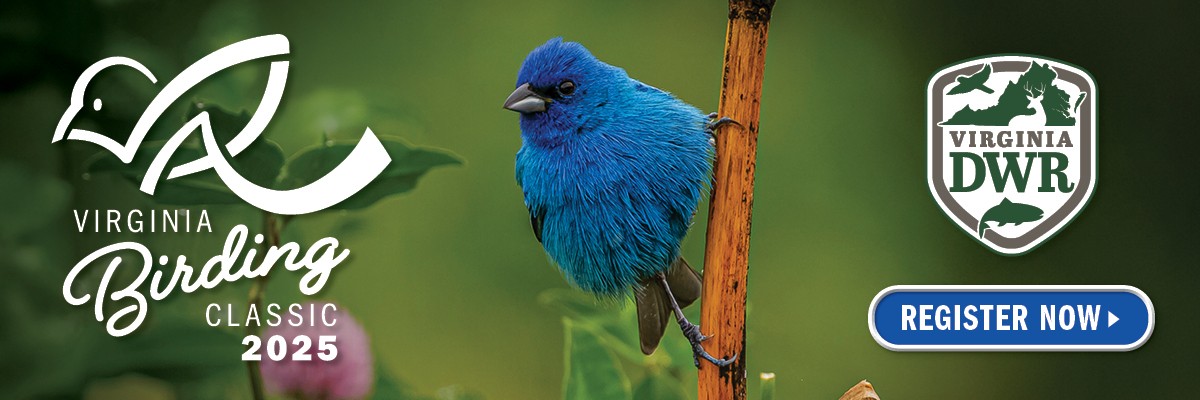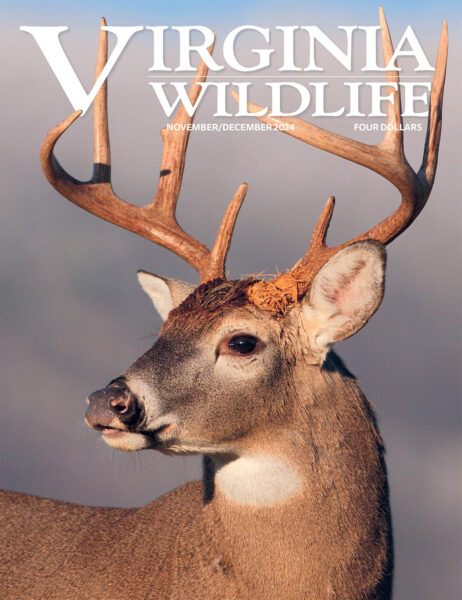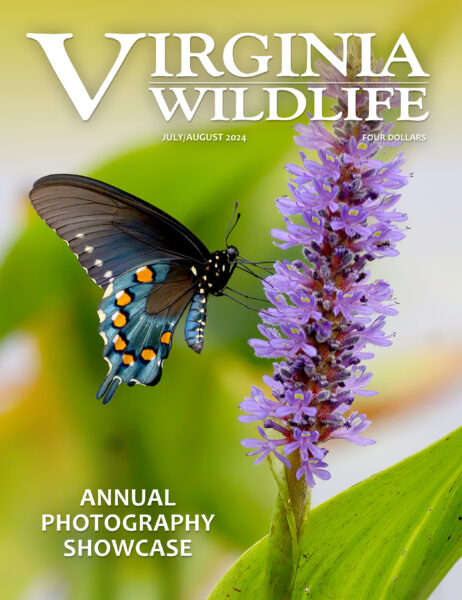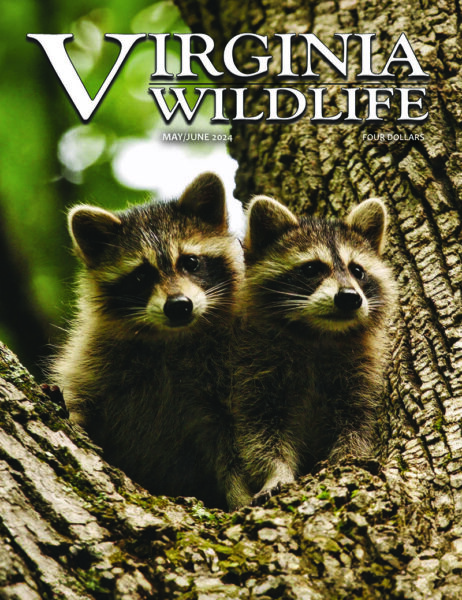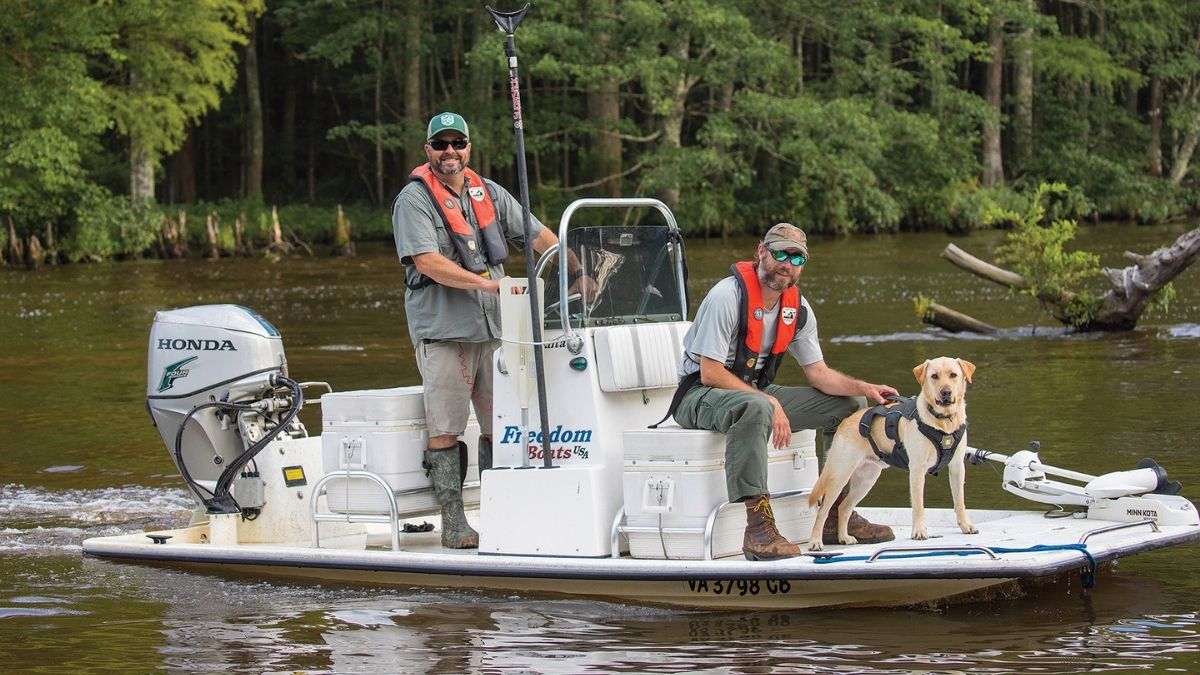
DWR biologists Todd Englemeyer (at the helm) and David Garst (holding the nutria detection dog Finn) on patrol for signs of nutria.
By Ron Messina/DWR
Photos by Meghan Marchetti/DWR
It’s a typical summer afternoon on the Upper Chickahominy River. There’s a scattering of small fishing boats, and tons of wildlife everywhere you look—frogs, geese, turtles, and ducks. A bald eagle soars away, over the tall pine trees. Massive cypresses, anchored in place with their numerous knees, line both sides of the river’s edge, completing the feel of a bayou. It’s peaceful, serene. You would never know anything could be wrong with this picture. But an animal called nutria (Myocastor coypus) threatens the very existence of this marsh.
Just what are nutria, and why are they so dangerous to this river?
Nutria are large, invasive, semiaquatic rodents. Covered with fur, rat-tailed, and web-footed, they’re similar in appearance to the native muskrat, although much bigger and far more destructive. With their large orange, beaver-like teeth, nutria will eat just about every plant that grows in a marsh. Once established, they are capable of mowing down and digging every available acre of beautiful wetland landscapes, thus turning them into bare patches of mud that then become eroded to open water over time.
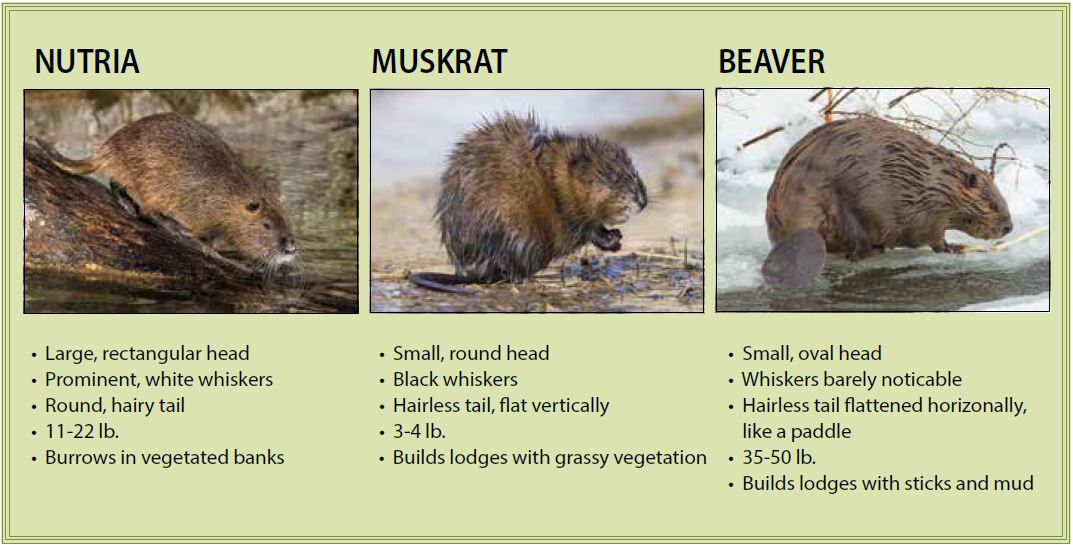
Uprooting the Habitat
But letting that happen on the Upper Chickahominy is not an option. There’s a white boat comin’ up the river, one with no sides and a flat deck designed to float in just a few inches of water. At the wheel is Todd Englemeyer, a Virginia Department of Wildlife Resources
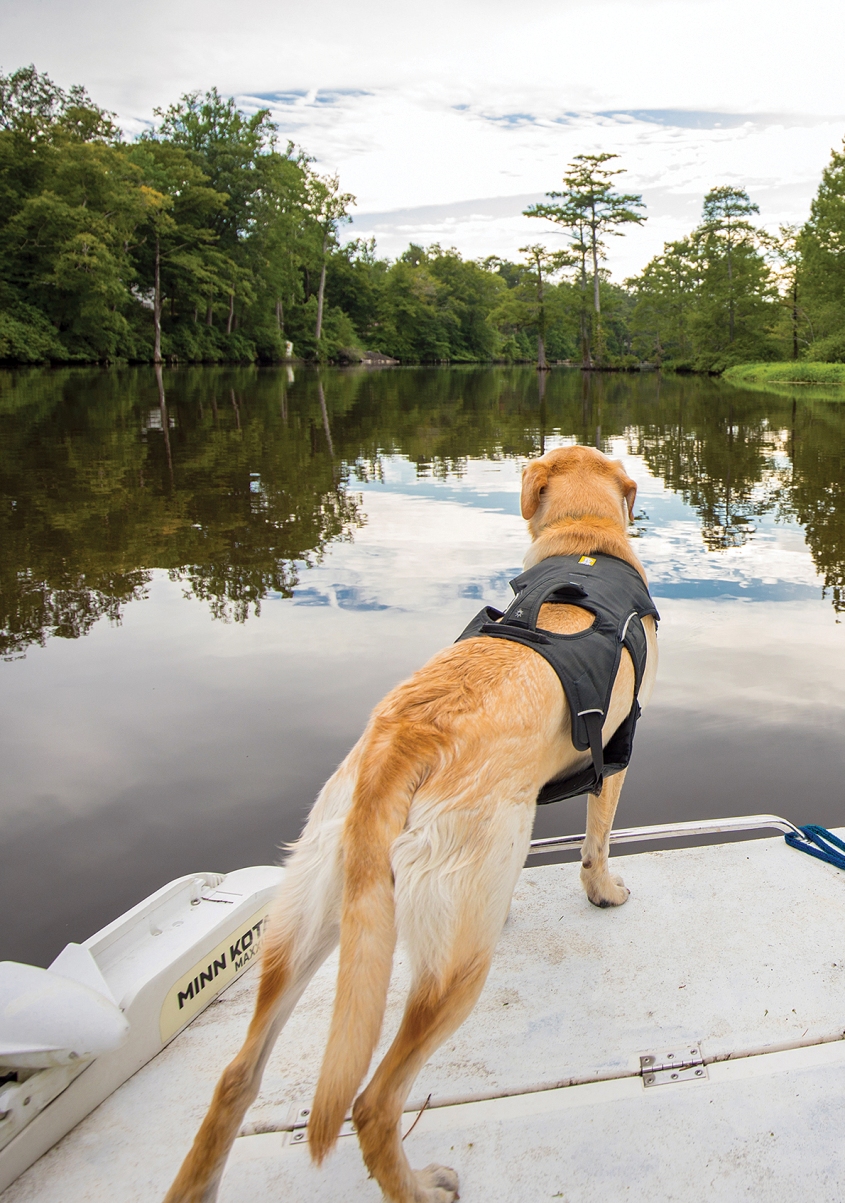
Detection dog Finn tests the air for nutria as the boat moves slowly along the Chickahominy.
(DWR) biologist, along with his constant companion, the nutria detection dog Finnegan. The boat takes up speed with Finn standing firmly in the bow, his ears flapping in the wind. Todd and Finn work together, or often along with DWR biologist David Garst, to find, detect, and eradicate nutria.
Englemeyer and Finn—one of only a handful of “conservation dogs” in use to find nutria throughout the country—work in coordination with other partner agencies, both state and federal. When they find evidence of a nutria, the location is promptly uploaded to a nationwide database. Then traps are set to kill the invasive animal.
Englemeyer explains why this is necessary. “Ultimately what makes nutria so bad is that they outcompete our native wildlife by destroying their habitat. They dig up and eat the root systems in the emergent vegetation, and our plant systems aren’t able to recover from it. So they destroy what’s holding those soils together. When you have big rain events, you get erosion, and we end up losing our marshes and all the wildlife that depend on them,” he said.
The boat snakes upriver past arrow arum, wild rose, and century-old bald cyprus before entering the expanse of Chickahominy Lake and motoring into a cove where the skeleton of an old duck hunting blind bakes in the sun.
Just a few years ago, the wooden structure sat hidden in the brush along the shoreline. Now the land around it is gone, and the blind is surrounded by open water. Englemeyer suspects nutria may have altered the landscape, by literally erasing the lush marshland around the blind.
Mike Fies, DWR’s furbearer biologist, explains that nutria leave nothing but mud flats in their wake, mud flats that are ultimately reclaimed by open water. If anything manages to grow back it’s usually invasive plants like phragmites with little value to native wildlife species. The food for ducks and all the plants that wildlife depend on in a thriving, green marsh disappear.
“Nutria reduce the availability of wetland habitats for many species of amphibians, reptiles, birds, and mammals that are uniquely adapted to these aquatic environments,” said Fies.
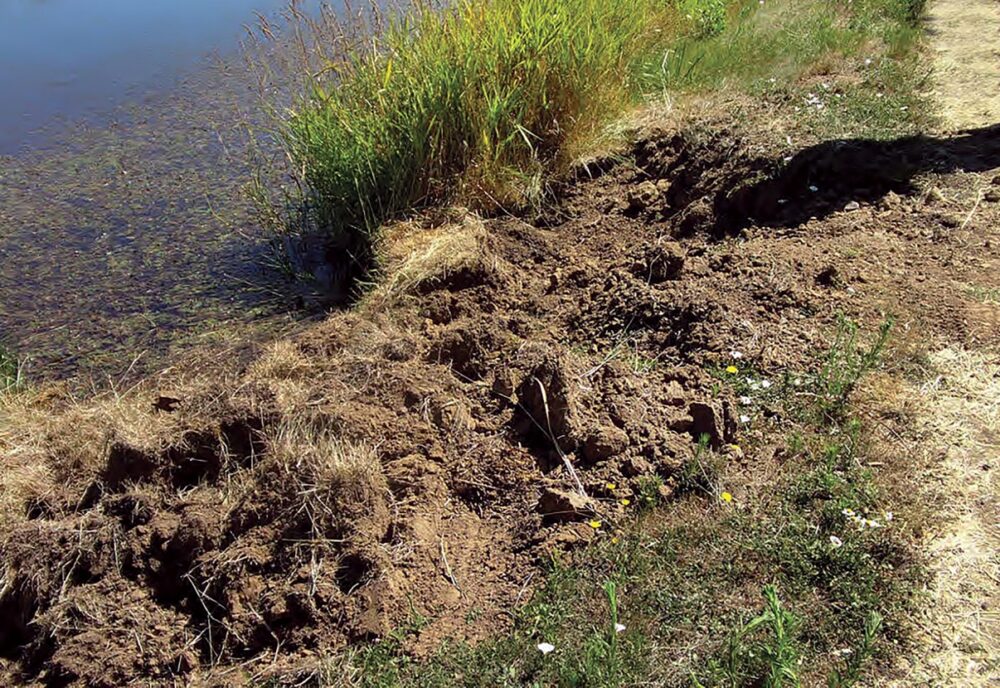
This example of damage by nutria reveals how badly nutria can impact a delicate wetland environment. Photo courtesy of U.S. Fish and Wildlife Service
Not On This River
Nutria are native to South America, but were introduced into Louisiana and several other states by commercial fur farmers beginning in the late 1800s. Eventually many of the fur farms went bust and the nutria escaped or were released into the wild.
Nutria crossed into Virginia from North Carolina, slowly creeping their way along the eastern coastal rivers and wetlands. It took them 50 years to expand their range north of the James River, but the Chickahominy is currently the northernmost river system they’ve entered in Virginia.
Englemeyer explains why it’s so important to stop them here and now, before nutria become established in the Chickahominy River and before they have a chance to wreck the pristine habitat.
“South of the James River we have nutria habitat, but it’s mostly black gum and bald cypress marshes that lack the emergent vegetation nutria thrive on—it’s suboptimal habitat for nutria,” said Englemeyer. “But north of the James River, we have incredibly ecologically significant river systems that are perfect habitat for nutria. They include the Chickahominy, the Mattaponi, the Pamunkey, Dragon Run—these rivers are beautiful and ecologically significant, and we want to protect them. The Chickahominy is just a stepping stone or gateway to all the rivers north and west of here.”
He swings the boat into a thick edge under a cypress canopy. Water rolls across the stern of the skiff as it slows. Directly ahead in the water is a square wooden platform with wires attached on top. It’s a nutria detection platform, designed to attract nutria with a scent lure. Once an animal climbs up, the wires snag a bit of fur from it, from which the species can be visually confirmed.
He checks the wires—there are no signs of fur on this one. Finn jumps off the boat to search the area. If he smells nutria, he’s trained to alert. Nothing at this one, but there are more platforms to check today.

David Garst checks for hair samples on one of many nutria detection platforms.
Saying No to Nutria
The use of detection dogs for many reasons goes back thousands of years, however their use in conservation is a more recent development. Nutria dogs and platforms were first developed by the United States Department of Agriculture (USDA) in Maryland, when the Blackwater National Wildlife Refuge on Maryland’s Eastern Shore became overrun with the animal. The new tactics to find and target nutria worked there, but it was a long, costly process. With the hard work of and help of many partners, including local trappers, about 8,000 nutria were removed from the Blackwater NWR, which resulted in a complete eradication.
Jonathan McKnight, Associate Director of Maryland Department of Natural Resources’ (DNR) Wildlife and Heritage Service, says it took almost 20 years of hard work and 27 million dollars to eradicate nutria from Maryland. He’s thrilled Virginia’s wildlife managers are taking steps to monitor and eliminate the rodent.

Nutria damage can decimate delicate wetland ecosystems.
“I’m gratified to see Virginia taking this threat seriously,” said McKnight.
“Virginia’s Chesapeake Bay marshes are among the most beautiful and productive places in the world. An uncontrolled nutria population could destroy them and leave desolation behind.”
That desolation could also include loss of revenue and jobs. Scott Klopfer, director of the Conservation Management Institute at Virginia Tech, says research is underway to study potential loss of commercial fishery and recreational angling revenue and jobs related to nutria damage, tracking the ripple effect across multiple sectors of Virginia’s economy. He estimates, if left unchecked, the cost of habitat loss from nutria damage could easily total in the tens of millions here in Virginia.
“Coastal marsh systems are already facing a number of threats and stressors, and adding nutria to the system will undoubtedly accelerate loss, or magnify degradation, or potentially both. As Maryland has demonstrated, this can be prevented, but the time to act is now,” Klopfer said.
Even with all the partners on board, more resources will be needed to stop nutria. Assistance may be coming with a timely act of Congress; in October of 2020, Congress amended the Nutria Eradication and Control Act of 2003 to provide federal funds to any state that can demonstrate a need for nutria control. Fies, Englemeyer, McKnight, and Klopfer are all hopeful Virginia will receive a share of the available funds. For now, the partners are doing what they can with the resources they have.
Back at ground zero in the battle with the invasive pest, Englemeyer points his boat back down the Chickahominy. No nutria were discovered this trip, which is good, but not unusual for summer, when the animal is more elusive. It’s the end of the long day, the sky is still bright, but twilight is coming. Asked how it makes him feel to be working on the front lines to protect this beautiful marsh, Englemeyer said, “You know, that sunset is all the thanks you need.”
Ron Messina is the video production manager for the Department of Wildlife Resources and an avid hunter.
About Nutria
- The word “nutria” comes from the Spanish word for otter. To avoid confusion, the species is known as “coypu” in Spanish-speaking countries.
- Nutria are prolific breeders, reaching sexual maturity in four to six months and breeding year-round in most of their range. They produce up to three litters each year of four to five young, a reproduction rate that left unmanaged can quickly lead to thousands upon thousands.
- In the wild, nutria rarely live longer than three years. Most adult nutria weigh between 15 to 30 lbs.
- Nutria can eat 25 percent of their body weight in vegetation in a day, and they feed year-round. They dig up the roots of plants to eat, destabilizing the soil.
You Can Help Protect the Wild
Private landowners, citizens, and conservation organizations can help protect our valuable wetlands in Virginia. You can assist by:
- Report any nutria you see to: https://cmi.vt.edu/ReportNutria. html. If possible, try to get a photograph of the animal before sending in the report.
- Educate your friends and neighbors about nutria and encourage them to also report sightings.
- Make your Congressional leaders aware of the funds authorized in H.R. 3399, an amendment to the Nutria Eradication and Control Act of 2003.

This article originally appeared in Virginia Wildlife Magazine.
For more information-packed articles and award-winning images, subscribe today!
Learn More & Subscribe

